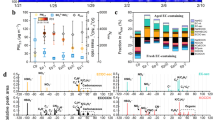Abstract
Atmospheric particulate matter is altering climate. For instance marine biogenic particles are cooling climate. Organic markers are major tools to elucidate the sources of atmospheric particulate matter. Formate is commonly used as a marker of continental aerosols, whereas methanesulphonate is used as tracer of biogenic marine aerosols. However, transformation processes during aerosol transport may modify their relative concentrations and, in turn, introduce a bias in the assessment of particle sources. Actually very little is known about the transformation of formate and methanesulphonate in aerosols. Therefore, we irradiated formate and methanesulphonate in the presence of nitrate and haematite. Nitrate and haematite are aerosol photosensitisers, producing reactive species that degrade organic compounds. The time evolution of formate and methanesulphonate was monitored by ion chromatography. Our results show that formate is transformed from 1.6 to 4.1 times faster than methanesulphonate. This trend is partly due to higher reactivity with the hydroxyl radical and partly due to additional reaction with other transients such as nitrogen dioxide. Such results strongly suggest faster formate transformation during particle transport. Therefore, when formate and methanesulphonate are used as particle tracers, an overestimation of marine biogenic versus continental particle sources is expected. This bias has major implications for climate prediction models, because marine biogenic particles have a cooling effect on climate.



Similar content being viewed by others
References
Anderson CH, Dibb JE, Griffin RJ, Hagler GSW, Bergin MH (2008) Atmospheric water-soluble organic carbon measurements at Summit, Greenland. Atmos Environ 42:5612–5621
Borghesi D, Vione D, Maurino V, Minero C (2005) Transformations of benzene photoinduced by nitrate salts and iron oxide. J Atmos Chem 52:259–281
Buxton GV, Greenstock CL, Helman WP, Ross AB (1988) Critical review of rate constants for reactions of hydrated electrons, hydrogen atoms and hydroxyl radicals (•OH/•O−) in aqueous solution. J Phys Chem Ref Data 17:293–465
Chiron S, Comoretto L, Rinaldi E, Maurino V, Minero C, Vione D (2009) Pesticide by-products in the Rhone delta (Southern France). The case of 4-chloro-2-methylphenol and of its nitroderivative. Chemosphere 74:599–604
Cwiertny DM, Young MA, Grassian VH (2008) Chemistry and photochemistry of mineral dust aerosol. Annu Rev Phys Chem 59:27–51
Fattori I, Becagli S, Bellandi S, Castellano E, Innocenti M, Mannini A, Severi M, Vitale V, Udisti R (2005) Chemical composition and physical features of summer aerosol at Terra Nova Bay and Dome C, Antarctica. J Environ Monit 7:1265–1274
George IJ, Anastasio C (2007) Release of gaseous bromine from the photolysis of nitrate and hydrogen peroxide in simulated sea-salt solutions. Atmos Environ 41:543–553
Hoffmann MR, Martin ST, Choi W, Bahnemann DW (1995) Environmental applications of semiconductor photocatalysis. Chem Rev 95:69–96
Jourdain B, Legrand M (2001) Seasonal variations of atmospheric dimethylsulfide, dimethylsulfoxides, sulfur dioxide, methanesulfonate and non-sea salt sulfate aerosols at Dumont d’Urville. J Geophys Res 106:14391–14408
Khare P, Kumar N, Kumari KM, Srivastava SS (1999) Atmospheric formic and acetic acids: an overview. Rev Geophys 37:227–248
Kuhn HJ, Braslavsky SE, Schmidt R (2004) Chemical actinometry. Pure Appl Chem 76:2105–2146
Mack J, Bolton JR (1999) Photochemistry of nitrite and nitrate in aqueous solution: a review. J Photochem Photobiol A Chem 101:89–103
Maddigapu PR, Minella M, Vione D, Maurino V, Minero C (2011) Modeling phototransformation reactions in surface water bodies: 2,4-dichloro-6-nitrophenol as a case study. Environ Sci Technol 45:209–214
Nissenson P, Dabdub D, Das R, Maurino V, Minero C, Vione D (2010) Evidence of the water-cage effect on the photolysis of NO3 − and FeOH2+. Implication of this effect and of H2O2 surface accumulation on photochemistry at the air-water interface of atmospheric droplets. Atmos Environ 44:4859–4866
Pu Z, Cao M, Yang J, Huang K, Hu C (2006) Controlled synthesis and growth mechanism of hematite nanorhombohedra, nanorods and nanocubes. Nanotechnology 17:799–804
Raman RS, Hopke PK (2006) An ion chromatographic analysis of water-soluble, short-chain organic acids in ambient particulate matter. Int J Environ Anal Chem 86:767–777
Siffert C, Sulzberger B (1991) Light-induced dissolution of hematite in the presence of oxalate: a case study. Langmuir 7:1627–1634
Vione D, Sur B, Dutta BK, Maurino V, Minero C (2011) On the effect of 2-propanol on phenol photonitration upon nitrate photolysis. J Photochem Photobiol A Chem 224:68–70
Acknowledgments
Financial support by PNRA—Progetto Antartide and MIUR—PRIN 2009 (project 20092C7KRC-ARCTICA) is kindly appreciated.
Author information
Authors and Affiliations
Corresponding author
Rights and permissions
About this article
Cite this article
Parizia, F., Maurino, V., Minero, C. et al. Faster phototransformation of the formate (terrestrial) versus methanesulphonate (marine) markers of airborne particles: implications for modelling climate change. Environ Chem Lett 10, 395–399 (2012). https://doi.org/10.1007/s10311-012-0365-3
Received:
Accepted:
Published:
Issue Date:
DOI: https://doi.org/10.1007/s10311-012-0365-3




